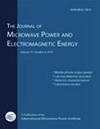编者按:验证微波加热模型的冷却演变
IF 1.5
4区 工程技术
Q4 ENGINEERING, CHEMICAL
Journal of Microwave Power and Electromagnetic Energy
Pub Date : 2021-08-31
DOI:10.1080/08327823.2021.1959236
引用次数: 0
摘要
以进行过程为目的的加热是微波最重要的非通信应用之一。考虑到温度作为设计不同系统(如固化、烧结、干燥或食品烹饪)的变量的重要性,人们对测量技术以及建模和仿真非常感兴趣。由于了解材料在加热过程中的热分布及其演变是非常重要的,因此人们在设计温度测量仪器和装置以及建立计算热分布和温度分布的数学模型方面付出了很大的努力。在微波加热的情况下,模型的温度测量和验证都非常困难。除了传导、对流和辐射(红外)传热机制外,在微波的情况下,样品内产生的热量取决于电场分布,电场分布取决于样品的介电常数,介电常数取决于温度,而温度又取决于电场和介电常数。不可能有一种均匀的材料,成分上的细微差别会影响到其他一切。在大多数情况下,唯一可用的信息是外部温度。这是工程中常见的问题,称为边值问题。传热用微分方程来描述,用解析或数值解来描述样品内部的温度。在传统加热的情况下,可以插入热电偶来跟踪热演变,但在微波的情况下,这就更复杂了,因为即使它们能正确地感知温度,它们也会影响电场。模型的有效性取决于描述通常被称为“多物理场”的相关现象的一组方程的准确性,以及系统的正确的热学和电磁特性,以及对不同变量的性质的函数关系的了解。然而,用这种模型计算的热剖面需要某种形式的验证,并且碰巧无法看到样品的内部。可以在加热后找到达到温度的物理证据,例如固化区域,相变或熔融区域的确认,但在微波的情况下,这些信息不允许建立热剖面,因为它们可能是热源或热吸收器,因此验证热剖面的可能性有限。微波加热模型的验证可以在关闭微波后,集中在冷却部分进行,这样我们只在已知边界条件下的样品内进行传导。我们可以知道外部温度,然后我们可以跟踪这个过程。这个想法包括在特定条件下用微波加热样品,并在相同条件下用我们想要验证的模型计算样品的内部热分布。我们看不到内部本文章由计算机程序翻译,如有差异,请以英文原文为准。
Editor’s message: cooling evolution for validating microwave heating models
Heating with the purpose of conducting a process is one of the most important non-communication applications of microwaves. Given the importance of the temperature as a variable for designing different systems, such as curing, sintering, drying, or food cooking, there is a great deal of interest in measurement techniques, as well as modeling and simulation. Since it is very important to know the thermal profile and its evolution while heating of materials, there are great efforts in the designing of instruments and devices for temperature measurement, and the development of mathematical models for calculating the heat distribution and temperature profiles. Both, temperature measurement and validation of the models are in the case of microwave heating very difficult. In addition to conduction, convection, and radiation (infrared) mechanisms for heat transfer, in the case of microwaves the generated heat within the sample depends on the electric field profile that depends on the permittivity of the sample, that depends on the temperature, which in turn depends on the electric field and the permittivity. It is impossible to have a homogeneous material, slight differences in composition affect everything else. In most cases, the only available information is the external temperature. This is a common problem in engineering known as the boundary value problem. Heat transfer is described with differential equations, solved either analytical or numerical, to describe the temperature inside the sample. It is possible to insert thermocouples, in the case of conventional heating, to follow thermal evolution, but that is more complicated in the case of microwaves because even when they could sense the temperature correctly, they affect the electric field. Validity of a model depends on the accuracy of the set of equations for describing the involved phenomena often referred to as “Multiphysics”, and the right thermal and electromagnetic characterization of the system, as well as the knowledge of the functional relation of the properties with different variables. However, the thermal profile calculated with such a model requires some sort of validation, and it happens that the inner of the sample cannot be seen. Physical evidence of the achieved temperatures can be found after heating, such as cured zones, phase transformation, or confirmation of molten zones, but in the case of microwaves that information does not allow to build a thermal profile because they could be either thermal sources or thermal absorbers, therefore the possibility of validating a thermal profile is limited. The validation of microwave heating models could be conducted by focusing on the cooling part after the microwaves are shut off so that we have only conduction within the sample with known boundary conditions. We have access to the external temperature, then we can follow that evolution. The idea consists of heating a sample with microwaves at certain conditions and calculating the internal thermal profile of that sample at the same conditions with the model that we want to validate. We cannot see the internal
求助全文
通过发布文献求助,成功后即可免费获取论文全文。
去求助
来源期刊

Journal of Microwave Power and Electromagnetic Energy
ENGINEERING, CHEMICAL-ENGINEERING, ELECTRICAL & ELECTRONIC
CiteScore
2.50
自引率
6.70%
发文量
21
期刊介绍:
The Journal of the Microwave Power Energy (JMPEE) is a quarterly publication of the International Microwave Power Institute (IMPI), aimed to be one of the primary sources of the most reliable information in the arts and sciences of microwave and RF technology. JMPEE provides space to engineers and researchers for presenting papers about non-communication applications of microwave and RF, mostly industrial, scientific, medical and instrumentation. Topics include, but are not limited to: applications in materials science and nanotechnology, characterization of biological tissues, food industry applications, green chemistry, health and therapeutic applications, microwave chemistry, microwave processing of materials, soil remediation, and waste processing.
 求助内容:
求助内容: 应助结果提醒方式:
应助结果提醒方式:


